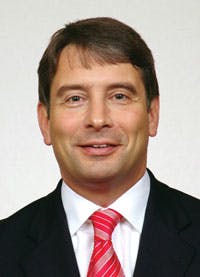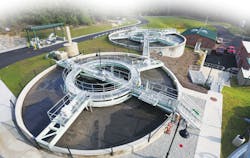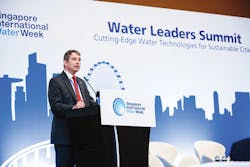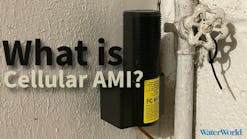CEO Lukas Loeffler Reveals All
Concentrating on the industrial automation side of the industry, Siemens is exiting the water treatment business. What does this mean for water equipment manufacturers out there? Who will make an ideal buyer? Tom Freyberg speaks to Dr Lukas Loeffler, CEO of Siemens Water Technologies to find out.
In an announcement just as monumental as the one back in 2004 when Siemens entered the water treatment business, it is now looking for a swift exit. Siemens Water Technologies (SWT) was put up for sale at the beginning of November 2012.
Speaking to Water & Wastewater International (WWi) magazine, Dr Lukas Loeffler, CEO of SWT, says: "Looking at the water treatment business that we run as a process company, I think this is clearly outside the main scope of Siemens Industry's future strategy.
"This strategy I would describe as automation and controls, drives, motion controls, sensors and actuators which are all part of the electrical automation business…We are dealing with the treatment of water, which is a process related technology and therefore outside of the core of Siemens Industry."
Nor was November a business month just for Siemens' water business. The group also agreed to buy the rail signalling division of Invensys Rail, the rail automation business of UK-based Invensys, for a whopping £1.7 billion.
"This is in line with the same strategy to strengthen the core and spin off businesses that are away from the core," adds Loeffler.
Water origins - USFilter
So when did Siemens – the well known German electrical engineering behemoth – start getting away from its so called "core" and enter the water treatment market? It was in 2004 (see timeline box out) when Siemens acquired USFilter from Veolia Environnement for $993 million. At the time the acquired business had reported sales of $1.2 billion and employed around 5,800 people.
USFilter was previously owned and then sold in 1999 by Dick Heckmann, CEO and company chairman of Heckmann Corporation.
"Heckmann started buying companies between 1991 and 1999 when he sold USFilter to Veolia. He had a couple of hundred smaller companies that he ran as a conglomerate. Veolia did little to make it [USFilter] a company but continued to more or less run it as a conglomerate. They tried to integrate but it didn't go very far," says the CEO.
Loeffler believes that part of the challenge for the company stemmed from the lack of initial integration of USFilter.
He says: "When the company came to Siemens in 2004-2005, initially the first leaders in Siemens were busy with a whole bunch of other topics. So from the point of view of managing the business, it was never integrated in a way that you had complete oversight of the individual locations, other than the financial level."
Loeffler took over as CEO of SWT, a business unit in Siemens Industrial Solutions Division from Chuck Gordon in October 2010. Since then he says he's been tightening up the different units of the group.
Following the sale of Siemens Water Technologies? Here are some additional articles that might interest you: |
Siemens acquired by private equity firm, changes name to Evoqua What does 2014 hold for Siemens Water Technologies, under AEA control? Siemens Water Technologies to be acquired by AEA Investors Why water was not the right fit for Siemens Siemens to focus water business on automation technology for future |
He told WWi: "What we have changed is the way we integrate processes, such as an overarching supply chain management, overarching order execution and engineering, as well as overarching R&D. We did away with the fragmentation that manifested itself in virtually dozens, probably three dozen local small site leaders, small local site managers that more or less ran their little sites independently.
"With a large company like Siemens, you cannot run a business based on 180 locations with 35 people in each. You need to integrate, create large critical mass and run it like a business. And also create synergies between the units. That's what we did effectively between 2010 and 2012."
Top dog ambitions
There is also another reason why Siemens has decided not to include water processing in its future strategy: fragmentation of the water market.
In the Siemens statement released to detail the sale of the water business, it states: "The bulk of the [SWT] business is geared to the standards in North America. Beyond that, the rest of the worldwide market is highly fragmented and dominated by local solutions."
Loeffler says this is why it's near impossible for a single company to be a global leader in water treatment – something Siemens seeks to achieve in all its divisions.
"If you look at the water industry - as the 10 largest players all together don't even reach a combined 10% market share, that's what we call fragmentation. It's not so much about the competition or competitive threats from new entrants. The observation is that it would be impossible to reach a substantial market share and really be in a strong position in the market with a handful of players – that's impossible in the water market today."
The CEO says one of the mantras of Siemens is to be competing in areas where they can be in the top three players, with sustainable, long-term growth. "That is difficult with the sheer fragmentation of the water market," he says.
When asked about the potential value of the group for sale, Loeffler says that figures are not being disclosed at this point in time.
Water – still an unfinished business?
Siemens is not exiting the water industry altogether. Flow, pressure and level meters, SCADA systems together with drive technology – for pipelines, pumps and agitators – will still be available from the company after the sale of SWT, from its Siemens Industry Automation and Drive Technologies divisions.
"That is all part of the Siemens strategy to continue to be the strongest player in automation and controls and on the drives side," adds the CEO. "When we talk about the business being sold we talk exclusively about the water treatment market, which includes the complete portfolio of the former USFilter acquisition but it excludes the recently transferred oil and gas technologies out of two locations that our Siemens Energy colleagues are still maintaining, as it makes part of their offering."
Since the USFilter acquisition in 2004 and rebranding of the business in 2006, SWT has been rapidly developing its technology offerings.
In 2007 the firm announced the opening of its Global Water Research and Development Centre at PUB's WaterHub building in Singapore – part of a 25 million Euro investment in the Asia-Pacific region.
One of the aims of the research centre was to improve efficiency of its Membrane Bioreactor (MBR) technology. Three years later and, as reported by WWi, the firm signed a licensing agreement for commercialisation of the EcoRight™ MBR system with Middle Eastern oil giant Saudi Aramco.
Two years later, in 2012, SWT relaunched its Vantage® M83 reverse osmosis (RO) membrane system for the European market. Previously the system had been launched in 2005 for the US market.
Investment potential
Such global activity should immediately pose as an enormous investment opportunity to buy a company with several years of development behind it. Although critics have said that potential buyers – such as Xylem or Pentair – would most likely be interested in single parts of the business, Loeffler confirms that SWT is being sold as a whole.
"The deal as we target it right now is the complete business, so we are not intending to sell the business in pieces and cut out divisions here or there – that doesn't make much sense for us," he says. "The major question is whether an industrial buyer or a financial buyer would have more interest in the business. I'm totally impartial here – both aspects have their pros and cons for our type of business."
So who would be an ideal buyer for SWT then?
"We would make a great match for any industrial player that could realise a lot of synergies. Our capability to generate great cash flow means we would also be an appealing target for a financial investor. This is a process that is yet to start and we'll see in due time what the shortlist in interested parties will look like in the end. I expect interest from both parties."
Loeffler's future
Regarding his role at the group, Loeffler will continue as CEO to lead the group into new hands. The decision on his role at the company will come down to the new owner.
"I would not have spent enormous time and effort over the last three years if I didn't believe in this business," he says passionately. "We have a great story to tell. This is an exciting time for us and also the industry, to not only write the next chapter in our history but also drive the market towards more open industrialisation and I want to be part of this deal of course."
About 4,500 employees work for SWT worldwide, with 3,000 of these based in North America.
Commenting on job security for employees, the CEO added: "I see a great chance for additional growth in an environment that's even closer to the water environment perhaps than Siemens. With Siemens being an electrical giant we were always a bit on the fringes of their typical activities. If we had a parent closer to the mainstream water technologies business, there are tremendous opportunities for growth. I'm not concerned about the prospects for the people."
Conclusion
The water sector has seen its fair amount of investment winners and losers over the years.
Take Pentair, which started in the paper market. Nearly 50 years later and the firm cemented its position in the water market by acquiring Dutch firm Norit Clean Process Technologies division for over 500 million Euros. The company has been reporting a series of new contracts ever since.
And who can forget Enron's well publicised rapid foray and exit with a $2.8 billion investment into UK utility Wessex Water, followed by the subsequent doomed creation of Azurix?
It's clear that the water sector and its politics are not to be taken lightly. While the Azurix fiasco was tied in with the utility, tariffs, customers and the political end of the market, the water processing offering of Siemens is not.
Dipping a toe in the proverbial water market is well advised before taking a full plunge. Perhaps the purchase of Siemens Water Technologies and its established product and R&D network would be one way of doing so.
Siemens Group Structure (units to be sold marked in orange)Siemens Water Technologies Timeline 2004 -> 2012 2004July – Siemens acquires USFilter December – Roger Radke named new CEO/Pres of USFilter, succeeding Andy Seidel 2005 February – USFilter exits sludge screw conveyor and bin/gate business [Asdor Products] August – Siemens takes majority stake in Tianjin National Water Equipment & Engineering Co., Ltd. joint venture [China] 2006January – Monosep Corporation is acquired [O&G] January – Altivia Corporation is acquired [WW odor and corrosion control, disinfection] July – Sernagiotto Technologies is acquired [wastewater treatment] August – USFilter is integrated into Siemens Water Technologies 2007January – WT acquires Sunlight Systems [disinfection products] January – WT acquires Envirotrol, Inc. and Clean Environmental Concepts (CEC), expanding service portfolio for activated carbon water treatment January – WT acquires Pure Water Solutions, expanding DI products/services June – Global water R&D center opens in Singapore 2008February – Chuck Gordon becomes CEO/Pres of SWT, replacing Roger Radke February – SWT expands in Middle East, with competence center in Abu Dhabi and Riyadh, Saudi Arabia March – Chemitreat Group is acquired, expanding water treatment technology and services in Asia-Pacific March – Fomento de Construcciones y Contratas, SA (FCC) purchases Hydrocarbon Services from Siemens April – Siemens announces reorganisation of WT business into four segments: municipal, industrial, services, chemfeed/ disinfection October – Siemens acquires SG Wasseraufbereitung und Regeneierstation GmbH [SG Water], to expand services in Europe **Siemens Water Technologies also created its international hub structure in 2008** 2010January – Siemens acquires Industrial Process Machinery (IPM) for industrial dewatering solutions June – Siemens announces expansion of water services/products in SE Asia September – Siemens announces expansion of water services/products in Europe October – Chuck Gordon steps down as WT CEO/Pres; Dr. Lukas Loeffler takes the helm 2011 – 2012Siemens implements and executes WT Turnaround Project to streamline and better integrate company globally 2012February – Siemens acquires Cambridge Water Technology [BioMag™ and CoMag™ technologies] April – O&G Water Solutions group transfers from WT to Siemens Energy May – Pace Analytical Services, Inc. purchases laboratory assets of Enviroscan Analytical™ Services from Siemens July – UGSI purchases certain chemical feed, liquid feed, and flow meter product lines from Siemens August – WesTech purchases conventional water treatment [General Filter / Microfloc] business from Siemens November – Siemens AG announces WT divestiture |
Fast Facts: Dr. Lukas LoefflerDr. Lukas Loeffler was appointed chief executive Officer of Siemens' Water Technologies Business Unit in October 2010. Previously, he served as vice president of the Siemens Mobility Infrastructure Logistics Business Unit. Prior to joining Siemens in 2005, he was general manager and CTO of the Banknote Processing and Services Division at Giesecke & Devrient GmbH in Munich, where he was responsible for his division's global R&D activities and worldwide service business. He has also held a variety of executive management positions at AEG's Postal Automation business (Konstanz, Germany), Daimler-Benz AG, and Robert Bosch GmbH (the two latter, in Stuttgart, Germany). Loeffler holds a master's degree in electrical engineering with a major in computer science and a Ph.D. degree in manufacturing engineering and automation from the Faculty of Mechanical Engineering at the University of Karlsruhe, Germany. |





